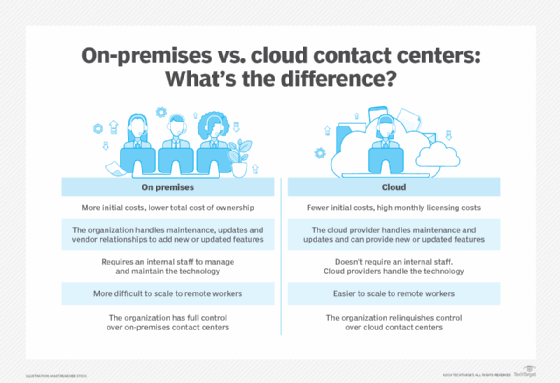On-premises vs. cloud contact center: What’s the difference?
On-premises and cloud contact centers differ in terms of costs, staff requirements and management. Organizations must weigh both options to find the right fit.
As cloud technology and its benefits have become more prevalent, organizations may find the switch from on-premises to cloud platforms compelling. However, an organization must carefully evaluate and understand the differences between on-premises vs. cloud contact centers before it chooses a platform.
What is a cloud contact center?
Cloud contact centers relinquish control of the software and hardware platforms to a vendor through cloud technology like SaaS. The organization loses ownership of the contact center platform — compared to the full control it has when the contact center is on its premises — but, in return, receives benefits from cloud technology that are not readily available in on-premises environments.
5 differences between on-premises vs. cloud contact centers
The main differences between on-premises vs. cloud contact centers are the following:
- costs
- maintenance and features
- staff requirements
- flexibility
- management
Costs
Contact center costs can be broken down into two parts: initial costs and ongoing costs.
Initial costs. Besides the initial professional services required to implement a cloud contact center platform, organizations face minimal upfront expenses, as they pay for licenses monthly.
With an on-premises contact center, organizations must make a significant capital outlay, or Capex, initially to acquire licenses. In many cases, these outlays require approval from a separate capital budget process within the organization. If the organization is measured from an EBIDTA — earnings before interest, taxes, depreciation and amortization — perspective, this type of cash outlay may have a negative effect on the organization’s financial reporting.
Ongoing costs. With a cloud contact center, organizations can more easily scale up or down to support business needs and pay only for the licenses and features they use. To take advantage of this capability, contracts with cloud providers must include flexibility for the required scaling.
In a cloud environment, monthly licensing costs primarily drive the total cost of ownership. Those monthly expenses begin to exceed the total cost of ownership for an on-premises environment in four to five years.
For an on-premises environment, organizations usually purchase a fixed number of licenses and pay annual maintenance fees for those licenses whether they are used or not. However, the total cost of ownership for an on-premises contact center is usually lower than a cloud environment. Even though organizations face a significant initial cost when they acquire on-premises systems, they still have ongoing annual maintenance costs.
In many cases, the on-premises environment is a fully amortized legacy platform. It has no moving parts, so the software’s life expectancy can extend for years until the platform reaches its end of life.

Maintenance and features
In a cloud contact center, cloud providers continually update and patch software so upgrades can occur with minimal to no interruption. If the software requires more significant upgrades, cloud providers have processes to minimize downtime and negative effects on their customers. Providers also include these upgrades in the basic prices of cloud platforms.
Many vendors also integrate additional contact center technologies and features — e.g., workforce management, analytics, etc. — into their cloud platforms. Many cloud providers have their own add-on features or have relationships with other vendors, so a customer does not have to manage relationships with multiple vendors. This is particularly valuable when an organization requires more advanced capabilities, such as AI.
With an on-premises contact center, the organization is often responsible for updates, patches and upgrades, which can require internal resources and additional expenditure. This may take the system out of production and interrupt business operations.
Organizations must also establish separate relationships with vendors that provide various add-on features for on-premises contact centers. The organization would work with the cloud provider and additional vendors to connect the various systems. However, if issues arise with the systems, this can lead to confusion among the vendors around who is responsible for what.
Staff requirements
With a cloud contact center, the vendor owns the technology environment and software. Hardware for many cloud services has minimal to no internal requirements and offers preestablished connectivity options, so the vendor maintains and updates the technology. Therefore, the organization does not need an extensive internal technical staff.
With an on-premises contact center, organizations need a technical staff to oversee hardware, telecommunications and, depending on the relationship with the vendor, software. In many cases, organizations — especially smaller companies — cannot support the expense of this staff or afford to spend unnecessary resources.
Flexibility
In a cloud environment, organizations can more easily support a remote workforce, as connectivity is established over the internet. For example, organizations in cloud environments could migrate to a remote work model more easily during the COVID-19 pandemic than organizations that operated strictly on premises.
Organizations with on-premises contact centers must work to ensure the internal infrastructure can scale to and support remote workers. While the organization has more control over the technology and operations in an on-premises environment, it lacks the flexibility to easily extend to remote workers and offices, as well as other benefits of cloud technology.
Management
If an organization adopts cloud contact center software from a specific vendor, the vendor likely cannot tailor the software to fit the organization’s specific business needs. Instead, the organization must be comfortable with the controls and reporting capabilities that the vendor implements to protect data.
In an on-premises environment, the organization has full control of data and implements the controls it deems appropriate for its data. An organization also controls the software’s functionality in an on-premises contact center and can implement specific requirements to support business needs.
Choosing between on-premises vs. cloud contact centers
Increased awareness of cloud technology’s benefits led various organizations to move from on-premises to cloud platforms. But, before an organization can make a decision between on-premises vs. cloud contact centers, it must fully understand the benefits and challenges of each so it can choose which would be the better fit for its business operations.
Courtesy of: Scott Sachs
